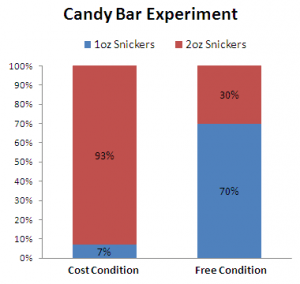Product Owner Zero Cost Effect
Have you ever had a stakeholder who wanted to change work priorities mid-project, mid-release, or mid-sprint? Certainly, one of the reasons we choose to use agile practices as a delivery mechanism is that it gives us the flexibility to change priorities. So, what if the change is mid-sprint? Isn’t that an irrational decision?
In Dan Ariely’s book, Predictably Irrational: The Hidden Forces That Shape Our Decisions, he described an experiment on 34 Halloween trick-or-treaters. As soon as the kids knocked on the door, they received 3 Hershey Kisses (each weighing about 0.16 oz.) and were asked to hold the Kisses they had just received in their open hand in front of them. Each child was then offered a choice between a small (1 oz.) and a large (2 oz.) Snickers bar, under a Cost Condition and under a Free Condition. In the Free Condition, they could simply get the small (1 oz.) Snickers bar (for free) without giving up anything or they could exchange 1 of their 3 Hershey Kisses for the 1 large Snickers bar. In the Cost Condition, the children could exchange 1 of their (0.16 oz.) Hershey Kisses for the small (1 oz.) Snickers bar or exchange 2 Hershey Kisses for the large (2 oz.) Snickers bar. They could also choose to do nothing (none of the kids went for that deal). Do the math and think about which choice you would make.
 Experiment results
Experiment results
In the Free Condition, in which the small Snickers bar is free, demand for it increases substantially (relative to the Cost Condition). The results demonstrate the attractiveness of zero cost. People gravitate more toward options that do not require giving up anything.
Example of this in reality
I’ve coached an organization where the Product Owner consistently wanted to add items from the Product Backlog to the current Sprint. During sprint planning, the team decided to reserve some capacity (add a buffer), to account for these unforeseen changes. Rather than killing the Sprint (or shortening it), the team chose the buffer. This would allow them to commit to new work without totally derailing the work already being completed. Yes, they could have used Kanban. But, Kanban wasn’t an option.
So, what happened? We offered the Product Owner a deal. We could allow him to add a certain amount of work to the Sprint for free. When we did this, he usually asked for smaller deliverables (relative to other items on the backlog that were also ready to work). But, when we said some work would have to come off the table to pay for the new work, he always went big. He would choose larger (complex) deliverables relative to other items on the backlog that were ready to work.
We truly are predictably irrational. So, have you had a Product Owner like this? Please add your stories to the comments below.

Comments (2)
Marcus Swope
My question is: What were the 30% of kids thinking who didn’t take the big candy bar for free????
;-)
Those kids were probably fearful of Ariely’s experiments. They probably thought it was a trap.